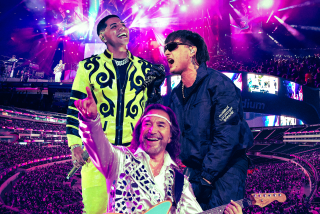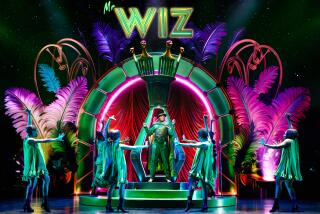The Bolshoi Stubs Its Toe on Capitalism
- Share via
LAS VEGAS — In its 221 years, the famed Bolshoi Ballet has never before faced box-office disaster.
But on its first U.S. tour since the fall of communism, the Bolshoi is learning up close about the pitfalls of capitalism.
The Bolshoi Ballet and Orchestra’s sterling reputation was supposed to be the draw as the troupe appeared first at the Aladdin Hotel here and then moved to Los Angeles’ Shrine Auditorium.
Instead of lines around the block, however, there is panic in hotel suites up and down the Strip among Bolshoi management and the presenters of the tour, the fledgling Russian Legends Productions of Oklahoma City.
The Bolshoi, which opened Oct. 8 at the hotel’s 7,000-seat Theatre for the Performing Arts, has drawn audiences estimaged at only 1,500 a night. Prices are steep--$30 to $95, with special $300 “Golden Circle” tickets including a reception with dancers--but no matter what you pay, ushers urge you to move down front to the best seats in the house.
And things don’t look much better for Los Angeles. The company is scheduled to open Oct. 23 at the 6,300-seat Shrine. The producers will not release exact figures, but they confirm that advance ticket sales have been very slow.
*
While it’s already too late for investors to see any profit from the two-city tour--which is expected to cost a total of $5 million--earlier this week Russian Legends’ biggest investor ponied up more of his own funds and has taken over the tour’s management reins in an 11th-hour effort to increase ticket sales in Los Angeles.
After learning of despairing talks of cancellation going on behind closed doors in Las Vegas, oilman Brad Haines, president of Haines Construction Co. pipeline contractors of Oklahoma City, jumped on a plane and headed for Las Vegas. He added another $400,000 to the $600,000 he had already invested, took over leadership from beleaguered Russian Legends head Ed Martin and has vowed that the show will go on in Los Angeles.
A group of fewer than 20 investors “with hearts as big as your hometown”--farmers, business people, their friends and relatives--chipped in funds ranging from as little as $500 to $50,000 to total about $400,000, Hines said Thursday by phone from his company’s branch office in Montana. The balance of the tour costs--fees for both venues, the Bolshoi’s travel, room, board and performance fees--was to come from ticket sales.
According to Los Angeles and Las Vegas dance and entertainment producers, many factors are causing the Bolshoi’s box-office woes, but they agree that the main problem is a series of bad marketing decisions, primarily insufficient advertising and promotion. They also say mistakes were made in choosing venues and in making assumptions about the size of the potential audiences and the extent of their pocketbooks.
A disappointed Vladimir Kokonin, executive director of the Bolshoi, interviewed in his hotel suite at Las Vegas’ MGM Grand Hotel and Casino, was quick to blame the American public, not bad marketing, for the slow ticket sales.
“We are in Las Vegas now, where they have an artificial New York, an artificial Cairo, an artificial Rome,” he said, referring to the city’s various theme hotels. “But now has arrived the real Bolshoi, and people won’t go to see it. Why? Crazy world!
“It is very strange situation for us--no public, for first time in history of the Bolshoi. We hope the situation in Los Angeles will be better.”
Los Angeles dance impresario James Doolittle said Las Vegas--where the troupe is booked for 12 out of 21 performances--is simply the wrong place for the Bolshoi. “I thought it was very strange, booking a venue in that city when the majority of people who go there don’t go to see ballet,” said Doolittle, who this season is presenting four international dance companies at the Music Center.
Doolittle said Russian Legends had approached him about backing the tour, but he declined, primarily because of suspicions about an unproven producer. Besides, he said, potential ticket buyers have become confused about the Bolshoi name. Over the last few years, tours have appeared under such names as “Stars of the Bolshoi,” employing dancers with only tenuous connections to the company, which has been going through management and personnel changes since 1995. Doolittle also said the reconfigured Bolshoi is not yet presenting any newsmaking repertory but instead recycling “Swan Lake,” “Don Quixote” and “Les Sylphices,” ballets that other prestigious companies have also presented recently in Southern California.
Tickets costing up to $300 are “ridiculous,” according to Doolittle. Major, full-company ballet tours are usually nonprofit ventures, he said, so tickets are not priced to turn a profit. He added that even world-class companies such as Britain’s Royal Ballet have held their top price to about $65 in Los Angeles.
Alan Feldman, spokesman for Mirage Resorts in Las Vegas, argued that the Las Vegas portion of the tour might have succeeded. Today’s Las Vegas crowd is sophisticated enough for the Bolshoi, he said, but the investors underestimated the need for competitive marketing. He said there were few display ads, billboards, radio interviews and the like--and added that quotes from a rave review in the Las Vegas Sun could have been used to the company’s advantage in advertising--but weren’t.
“This is a town that makes a lot of noise, and, especially if you are going to be here for a short period of time, you have to make an even louder noise,” Feldman said. “We’ve had any number of things in town--opera, Tony Bennett, Dance Theatre of Harlem--and they’ve done very well. In each of these cases, something had to be done to draw out the awareness of their presence.”
The Bolshoi’s Kokonin seems to think such awareness should be automatic. He blames the American audience, for instance, for being confused by “Stars of the Bolshoi”-style touring groups. “I have pity for American audiences who allow themselves to be deceived,” he said. “In Russia, nobody would go to a false Metropolitan Opera, they would know. Just generally, this is a problem of American cultural life, and it is a great pity for us.”
While for the investors this venture may represent a financial loss, for the Bolshoi its reputation is at stake. In the same breath in which he insisted that the Bolshoi has “lots of proposals” for tours and an image that cannot be sullied, Kokonin acknowledged that the troupe took a chance on the Oklahomans because of a lack of immediate concrete offers.
“We have never performed in Las Vegas, and the financial and other conditions were suitable for us,” he said. “Why should we just deny this proposal?”
Haines said both the Russian Legends investors and the Bolshoi walked into the deal with the best of intentions. Martin, a former Methodist minister, traveled to Moscow in 1992 with a church group, hosted by Alexander Abdrakhmanov, vice president of Moscow State University. Martin soon left church work to become manager of Oklahoma City’s convention center and sports arena. With the help of his new Russian friend, Martin arranged a series of U.S. games for the Russian National Hockey League in 1994-95.
In 1993, Martin formed Russian Legends Productions, and, again spurred on by Abdrakhmanov, began planning to bring the Bolshoi Ballet to Oklahoma. Instead of Oklahoma, however, they settled on Las Vegas, the “entertainment capital of the world,” in Martin’s words. They were aware that it was a largely untried market for international ballet, but, reasoned Martin, the quirky Cirque du Soleil was also a risk for Vegas, yet went on to become one of the most successful attractions in town. Adding Los Angeles, where the Bolshoi had a successful run at the Shrine in 1990, seemed a natural.
Both cities also offered huge theaters. Martin said the cost of bringing in the 250-member troupe necessitates selling enormous numbers of tickets. “There were six violoncellos; after I agreed to this contract I found out they had to ride on a seat in the plane. I asked: Do they have to go first class?” Martin joked.
*
While acknowledging that it may be too little too late, Haines is seeking public relations representation in Los Angeles, contacting experienced dance presenters for advice, and apparently hoping to drum up interest through sheer force of will. A last-minute effort is being launched to fly well-known Bolshoi ballet director Vyacheslav Gordeyev into Los Angeles for press interviews, and appeals are being made to the Russian government for additional help--Haines is even planning to offer his American know-how in the oil business in exchange for their support.
“The easy thing to do is to walk away, to leave the Russians stranded, to say I made a bad investment,” said Haines, acknowledging that he got involved at the suggestion of one of his bankers without researching the situation. “But with something like the Bolshoi Ballet, having a 221-year history of success--as an American I feel obligated to help.
“This is the real, historic Bolshoi Ballet. They want to dance; they want to perform. They were promoted into a bad situation, I was promoted into a bad situation. And, together, we intend to come to L.A. and perform.”
More to Read
The biggest entertainment stories
Get our big stories about Hollywood, film, television, music, arts, culture and more right in your inbox as soon as they publish.
You may occasionally receive promotional content from the Los Angeles Times.










